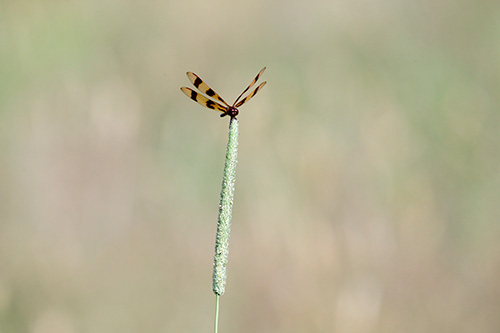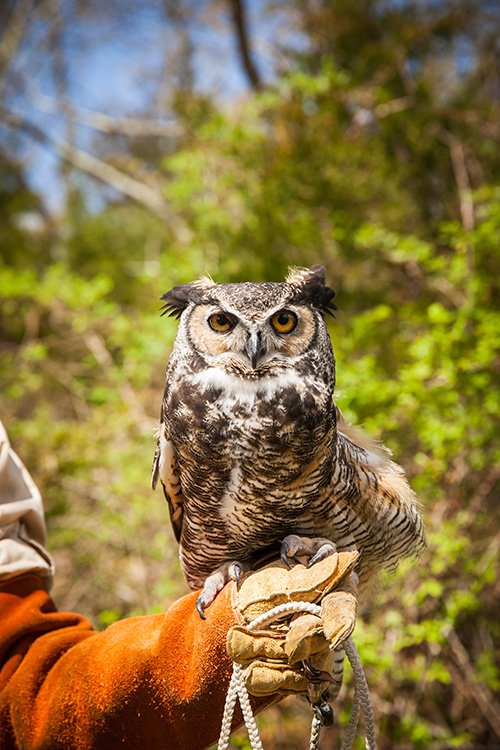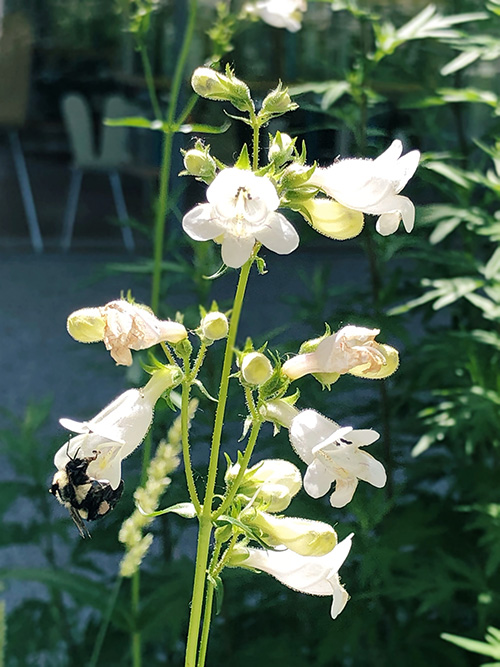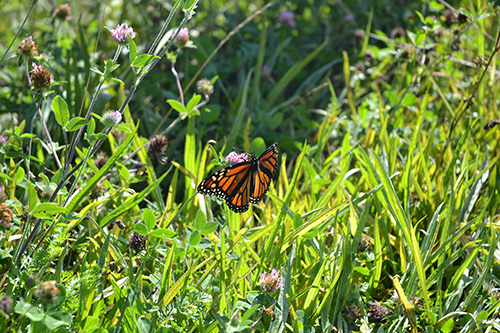Topics
In celebration of New Canaan’s launch to join the pollinator pathway movement, we thought it fitting to highlight the work of scientists, environmentalists, and writers, who open doors that allow us to explore and discover our unique relationship to nature. The launch of the pollinator pathway, a pesticide-free corridor of public and private properties that provides native-plant habitat and nutrition for pollinators, is an actionable and scalable response to the decline of our pollinators. While staving off the decline is important for our food production and survival on earth, the protection of the pollinators and nature touches us on many personal levels.
Through the words of great thinkers, both present and past, they can help us understand our profound connection to nature and why we are so moved to protect and restore it.
At Grace Farms, we’re committed like many other partnering organizations (see full list below), to be part of the solution. Mark Fowler, former Nature Initiative Director, reminds us that in the process of doing, we need to restore our relationship with our environment. “Like E.O Wilson, I remain hopeful,” Fowler says. “When we are hopeless, we aren’t going to care or want to be part of the solution.”
In our Library, we invite you to explore a wide selection of books on nature and the environment, ranging from the scientific journey of saving our planet to how nature is saving us. As we applaud the town of New Canaan, and our partners, for joining the pollinator-pathway movement, we remain hopeful about our future. In the seven books we highlighted – we hope they provide insights about the solutions and inspire us to make change.

We join New Canaan and our other partners in the pollinator pathway movement to restore pollinator habitats © Julien Jarry
A Sand Country Almanac
And Sketches Here and There
By Aldo Leopold
Aldo Leopold is considered to be the father of wildlife ecology and from an early age he had a great interest in nature. Considered one of the foremost conservationists of our time, the Almanac is considered a tour de force among conservationists. He is a member of the National Wildlife Federation’s Conservation Hall of Fame.
About the book: A Sand County Almanac is one of the cornerstones of modern conservation science, policy, and ethics. It was first published by Oxford University Press in 1949, and has since become a classic. Leopold uses A Sand County Almanac as a call to how we communicate about the true connection between people and the natural world. He worked on this book over a 12-year period, writing essays to inspire people to take actions to protect the health of the planet.
Excerpt: “There are some who can live without wild things, and some who cannot. These essays are the delight and dilemmas of one who cannot. Like winds and sunsets, wild things were taken for granted until progress began to do away with them. Now we face the question whether a still higher ‘standard of living’ is worth its costs in things natural, wild and free.”
The Future of Life
By Edward O. Wilson
Edward Osborne Wilson, considered the greatest living scientist of our time, is the University Research Professor Emeritus at Harvard. Wilson, a Pulitzer-Prize winning author, has also been a pioneer in preserving and protecting the biodiversity on this earth. He has written many books and articles on entomology and conservation. Wilson has also served on many boards including the American Museum of Natural History, The Nature Conservancy, and Columbia University’s Earth Institute.
About the book: When it comes to the future of earth we tend to embrace a doomsday scenario. Perhaps this is justified considering the evidence that supports the damage to the environment –and continue to do so. But in The Future of Life, rather than adding to doomsday prophesies, he outlines a plan to save the world. Wilson also believes there is still time. He offers a vision of hope, grounded in economic practicality.
Excerpt: “Surely the rest of life matters. Surely our stewardship is its only hope. We will be wise to listen carefully to the heart, then act with rational intention and all the tools we can gather and bring to bear. … Now science and technology must help us find a way through and out.”

Our programming helps educate about the importance of restoring habitats and living in harmony with nature © Vanessa Van Ryzin
Owl Moon
By Jane Yolen
Jane Yolen is an award-winning poet and writer of children’s literature. She has been called the Hans Christian Andersen of America and the Aesop of the twentieth century.
About the book: Jane Yolen’s story is poetic and depicts the special relationship between a young child and her father through discovering the natural world together. John Schoenherr’s soft and exquisite watercolor illustrations help tell the story.
Excerpt: “When you go owling
you don’t need words
or warm
or anything but hope.
That’s what Pa says.
The kind of hope
That flies
on silent wings
under a shining
Owl Moon.

The launch of the pollinator pathway in New Canaan will provide native-plant habitats and nutrition for pollinators © Ashley Sikora
The Invention of Nature
By Andrea Wulf
Andrea Wulf is the author of five acclaimed books, including The Brother Gardeners, Chasing Venus, and Founding Gardeners. Her latest book The Invention of Nature is a New York Times bestseller. She has written for The New York Times, The Atlantic, the Los Angeles Times, Wall Street Journal, the Sunday Times, and The Guardian.
About the book: In this biography of Alexander Von Humboldt (1769-1859), Wulf tells the story about how this visionary German naturalist and polymath, changed the way we think about the natural world. Humboldt’s ideas formed the foundation of modern environmentalism.
Excerpt: “Fascinated by scientific instruments, measurements and observations, he was driving by a sense of wonder as well. Of course, nature had to be measured and analyzed, but he also believed that a great part of our response to the natural world should be based on the scenes and emotions. He wanted to excite a ‘love of nature’. At a time when other scientists were searching for universal laws, Humboldt wrote that nature had to be experienced through feelings.”
H is for Hawk
By Helen Macdonald
Helen Macdonald is an English writer, naturalist, and an Affiliated Research Scholar at the University of Cambridge Department of History and Philosophy of Science. She won the 2014 Samuel Johnson Prize and Costa Book Award for H is for Hawk.
About the book: H is for Hawk is a memoir by Helen Macdonald, who grew up fascinated by birds, retreats from the world after the sudden death of her father. Her retreat, however, includes raising and training a young goshawk, notoriously difficult to tame. Mabel, the goshawk’s name, lives with Macdonald in her home. In the training and living together, Mabel helps Macdonald with her grief. As The New York Times’ book review wrote, “Although ‘animal as emotional healer’ is a familiar motif, Macdonald’s journey clears its own path — messy, muddy and raw.”
Excerpt: “I was alive, yes, but exhausted. I felt as if I were built of wool. Grey, loose-spun wool on an aching set of bones. My walks with the hawk were stressful, requiring endless vigilance, and they were wearing me away. As the hawk became tamer I was growing wilder.”

By joining the pollinator pathway with New Canaan and our partners we can restore habitats and bring back pollinators.
The Bee-Kind Garden
Apian wisdom for your garden
By David Squire
David Squire studied gardening at the Hertfordshire College of Horticulture and at the Royal Horticultural Society’s Garden at Wisley, Surrey. He has received the Garden Writers Association of America’s ‘Quill and Trowel’ award.
About the book: The book is filled with easy-to-understand and useful information about bees, accompanied by hand-drawn illustrations. The book reveals many facets about the life of bees, answering questions about their homes, flight patterns, and if bees prefer certain scents.
Excerpt: “The honey bee is a social insect, and for thousands of years before being domesticated they lived wild in groups. The evolution of bees was mirrored by the development of flowering plants and their need to be pollinated, ensuring the future for both plants and bees.”
Hope, Human and Wild
True stories of living lightly on the earth
By Bill McKibben
Bill McKibben is an author and environmentalist. He is the Schumann Distinguished Scholar in Environmental Studies at Middlebury College and a fellow of the American Academy of Arts and Sciences. McKibben is a former staff writer for The New Yorker; he writes for a variety of publications, including the New York Review of Books and National Geographic.
About the book: Unlike his bestselling book The End of Nature, McKibben offers hope for a sustainable future in Hope, Human and Wild. He believes that how we measure wealth in our society, by material acquisition and productivity, should shift to living with fewer material processions. By consuming fewer resources, McKibben thinks we can live in harmony in the natural world.
Excerpt: “I hate to admit my hope, for the word has been debased – as “hope” is used in the context of the environment, people always seem to hope that the scientists are wrong, hope that their warnings are just “doom and gloom,” hope that we’ll muddle through. … But that’s not hope – that’s wishing. Real hope implies real willingness to change, perhaps in some of the directions suggested by this volume.”
For more information about how you and your town can get involved visit pollinator-pathway.org. New Canaan joins many towns in Fairfield and Westchester Counties to restore pollinator habitats. Supporting the town of New Canaan in restoring native habitats currently includes partnering organizations: Grace Farms, the New Canaan Library, Planet New Canaan, New Canaan Nature Center, New Canaan Garden Club, New Canaan Beautification League, New Canaan Department of Public Works, New Canaan Land Trust, and the Norwalk River Watershed Association.
Sign up for our newsletter to learn more about Grace Farms’ ongoing programs and our initiatives: nature, arts, justice, community, and faith.

